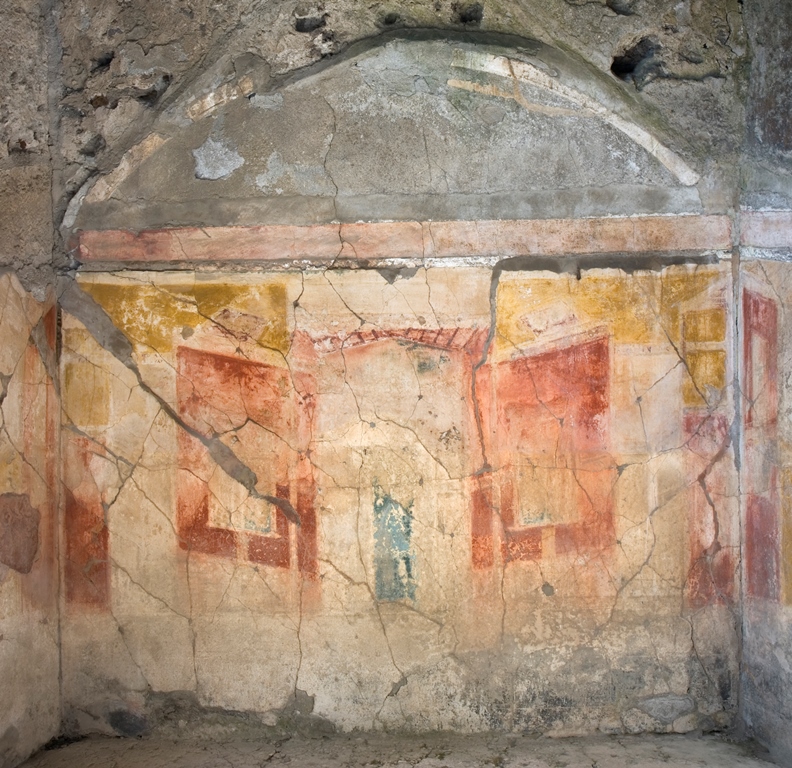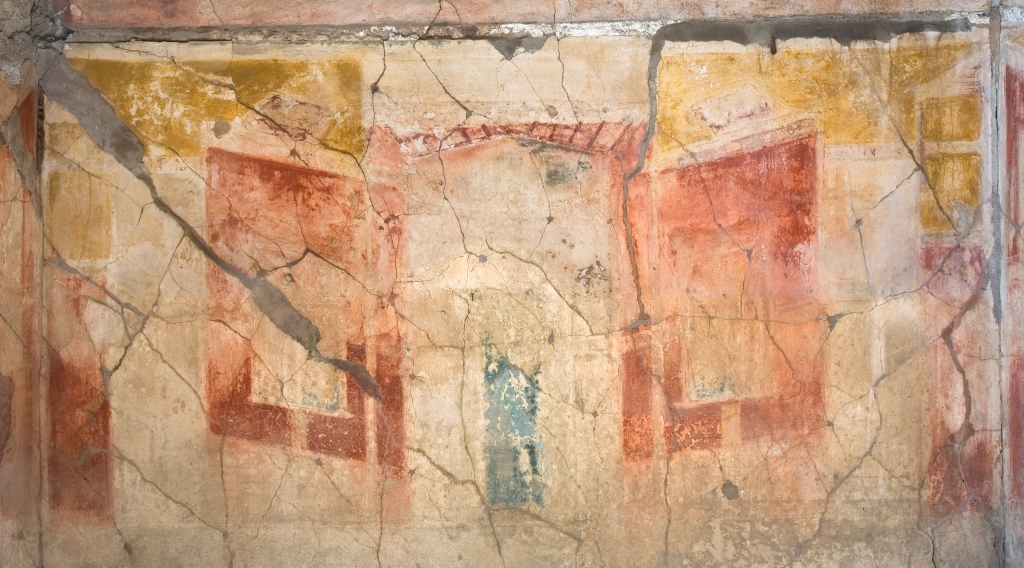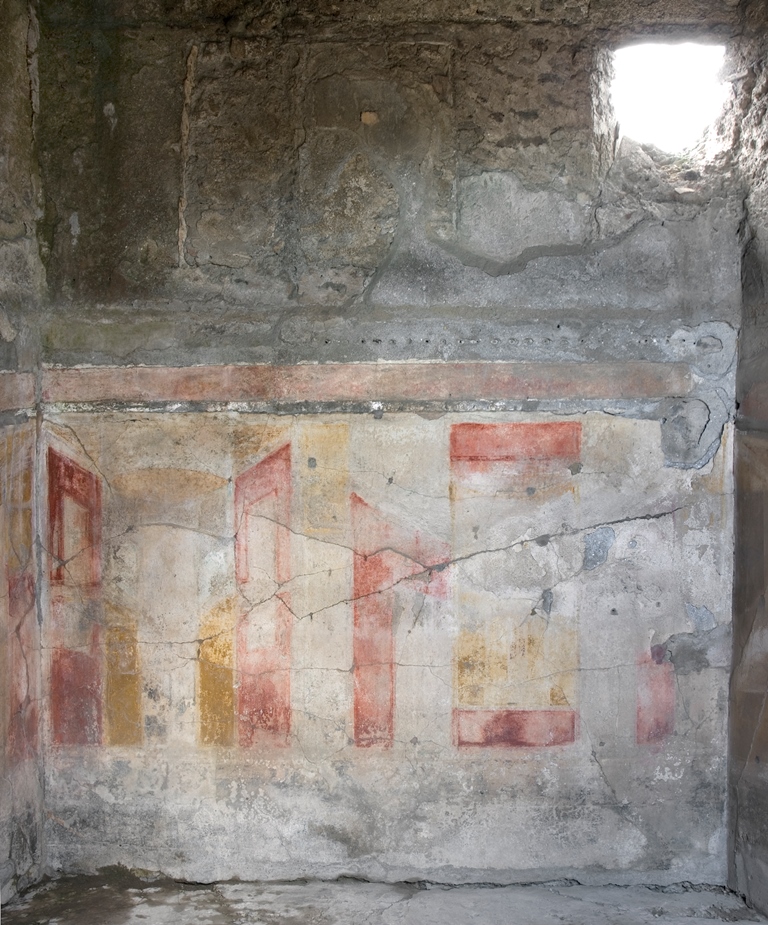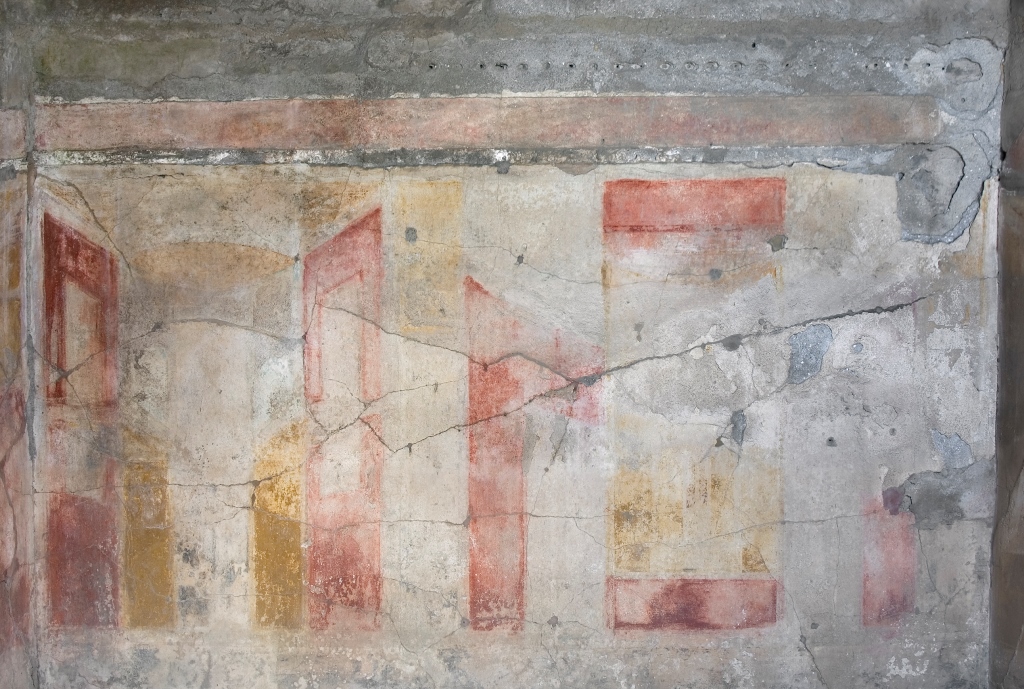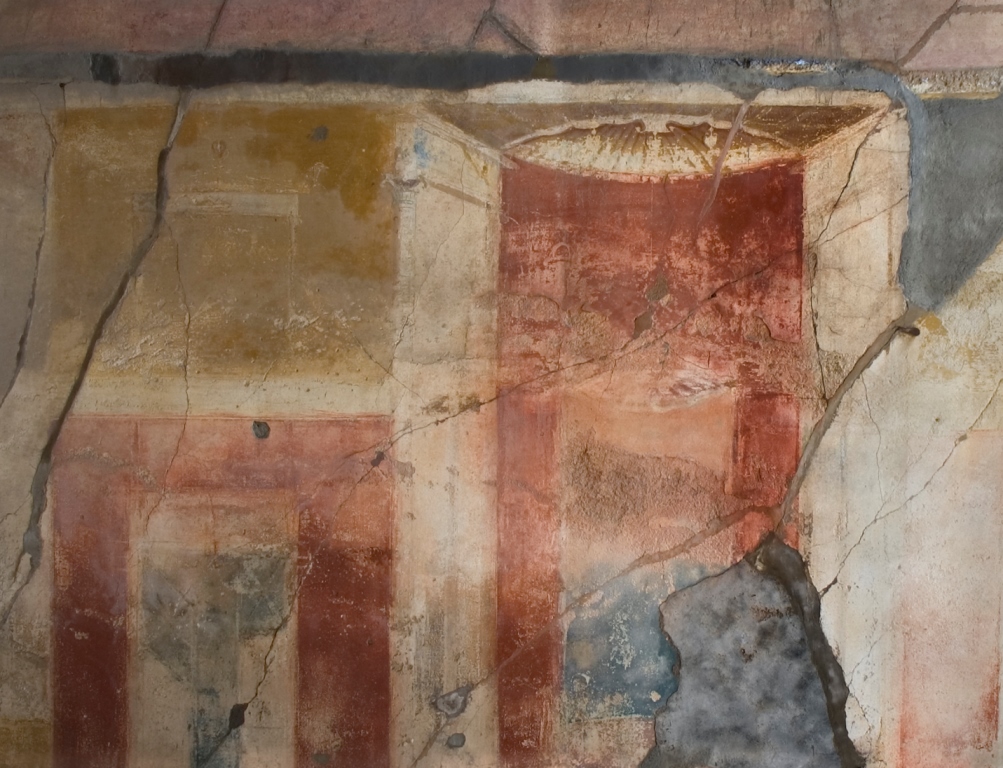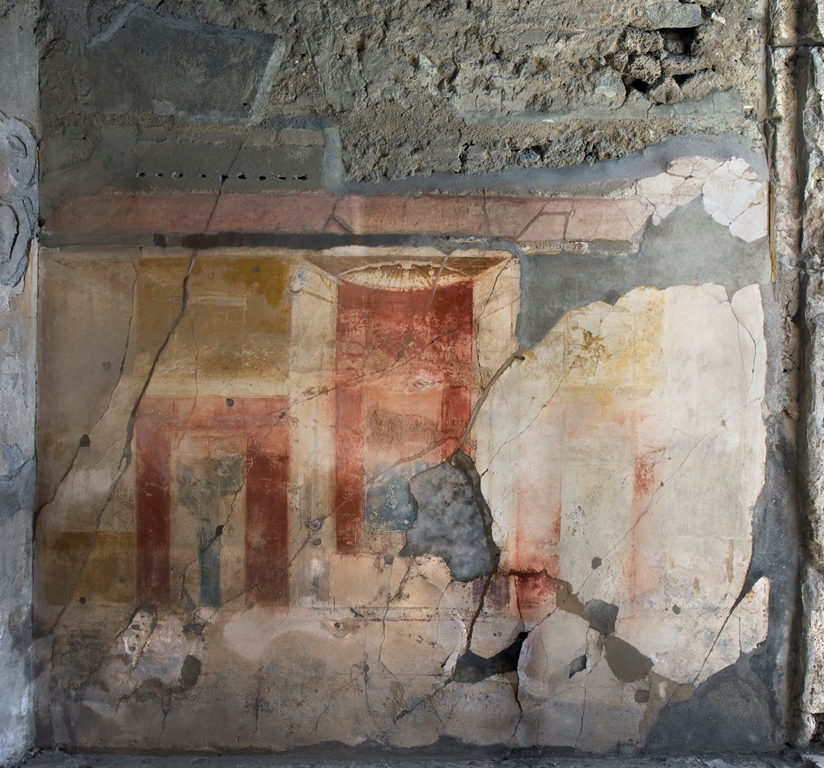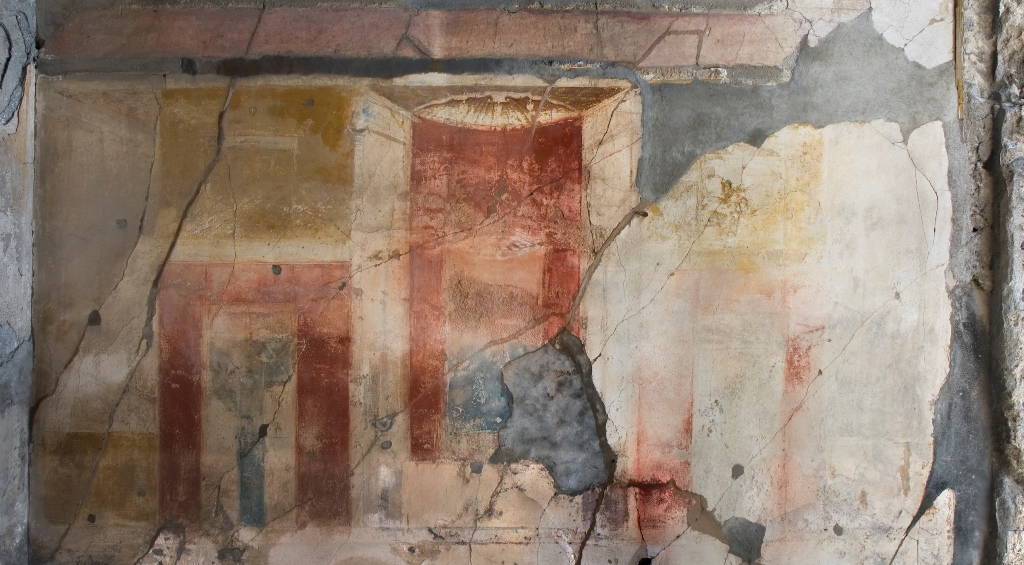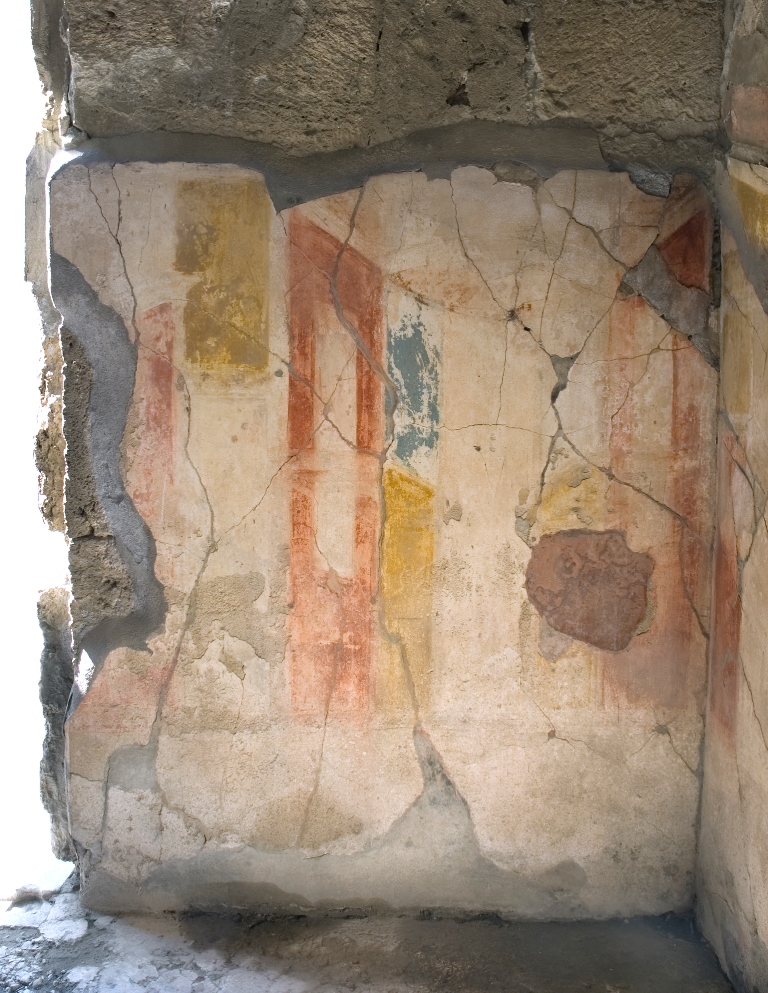Wall decoration (extant)
Description
Thomas Staub
North wall
This wall shows remains of decorations up to a maximum height of 3.4 m and under plaster up to 4.8 m height. The decorations show the usual three partitioning scheme of socle, middle and upper zone. The black socle zone is 0.68m high with mostly fainted away geometrical ornaments in a lighter colour. The middle zone is 1.49 m high and shows a symmetrical scheme with an aedicula in the centre, framed by architectural elements. The upper zone, separated from the middle zone by two stuccoed friezes (now lost) and a painted frieze has an arched form. The arch starts in 2.45 m height and the arch crown is situated in the height of 3.3 m. No remains of internal decorations are preserved.
East wall
The east wall shows as well remains of a complex, mature Third Style decorations, originally three parted into socle, middle and upper zone. Of the decorations of upper zone no remains are preserved above the dividing stucco frieze between middle and upper zone. The socle is again painted in a dark colour with decorations made by stripes in brighter colour. The middle zone, dominated by yellow and red is two parted, following the partioning of the room in an "ante-room" in the south and the probable location of the cline in the north. The southern part shows a higher aedicula, framed on both sides by shear walls and thereafter by a yellow area. The northern part also is decorated by an aedicula with framing architecture, but this slightly lower and with arched crowning.
S wall: The decorations on the south wall belong mostly to a mature third style. Remains of the socle zone and a middle zone are preserved, wherea nothing remains from the upper zone. A stuccoed cornice, of which nothing is preserved, crowned the middle zone; only a row of small holes is visible in the wall at 2.50 m h, where this was attached. Above these remains of an ornate frieze was discernible in the 1880ties, and by Mau attributed to a Second Style decoration (Mau 1882, p. 253). The decorations of the western part of the wall are poorly preserved, probably because they have been more damaged by the climatic influences as they are placed next to the door.
The socle has a dark ground with remains of brighter stripes. The middle zone shows a complex architectural system, mainly in yellow and red. It is symmetrically composed with a higher, shell covered aedicula in the centre, framed by smaller aediculae and shear walls.
West wall
The decorations of the west wall are the mirrored image of the northern part of the east wall, ending at the door opening towards atrium , i.e. after the northernmost wall related to the southern aedicula on the east wall. For a detailed description see the east wall of this room.
North wall
The decoration of the socle zone and the upper zone can no longer be defined due to the bad state of preservation.
The middle zone is composed in a symmetrical way, with a 0.74 m wide central aedicula of unknown colour, which a 0.19 m wide, 0.74 m high blue field in its centre, maybe a depiction of an open door. What was probably meant as the side walls of the aedicula is now visible only as two 0.1 m broad red stripes. The ceiling of the aedicula is trapezoid with clearly rendered beams running into the background. The upper side of the roof is formed as a straight line, between 0.04 and 0.11 m above the ceiling. Above this remains of two horizontal stripes can be made out, the lower one 0.08 m, the upper one 0.15 m high, both of unknown colour.
The aedicula is framed by a 0.04 m wide pilaster strip on each side. Thereafter follow walls, once more rendered in a perspective way, 0.54 m wide, framed on the external side by 0.03 m broad candelabras or columns, of which some remains of a capital are preserved on the eastern side. Since both sides of the aedicula show an identic composition, the description will continue with the slightly better preserved eastern side, the western one can be completed as a mirror image of this eastern one. In this wall a bluish field is in inserted with bevelled lower and upper sides. This field, probably a window is framed by two 0.03 m broad columns. The upper side is crowned by a cushion-like feature. The wall itself is topped by a two parted (0.08 and 0.02 m high) architrave, which is protruding in its upper part. In the centre of this architrave a garland is attached, which reaches down to the two framing candelabras. At the centre of this garland a ribbon hangs down at the end of which remains of a round ornament can be observed. A panel painting (0.2 x 0.12 m) is placed on top of the architrave, once more rendered in a perspective way. The panel is violet with remains of two round objects. The surrounding area is yellow up to the boundary towards the upper zone.
To the east of the above described area follows a 0.31 m wide field of light colour with a horizontal, 0.06 m high line in 1.85 m height that continues to the north eastern corner of the room with faint remains of ornaments in violet colour. 0.08 m beneath the centre of that line, remains of a round ornament, i.e. scores after a compass (diam. 0.075 m) are visible. Remains after a smaller architrave are maybe visible from about 1.38 m height, but the state of preservation is too bad to be sure. The easternmost part of the middle zone shows a further approx. 0.22 m wide aedicula, in the lower parts (up to a height of 1.52 m) red and above a green dividing stripe a 0.48 m high yellow area. The aedicula is crowned by an architrave that is rendered perspectival; the ceiling is rendered as a pan ceiling. The architrave is on its western side supported by 0.03 m wide columns. The north eastern corner itself is accentuated by a 0.045 m wide bright stripe.
East wall
The east wall of the room again shows a black socle zone, approx. 0.62 m high. It shows remains of two 0.008 m thick horizontal lines in a light colour, one in 0.2 m height, the other one in 0.4 m height, whereas no remains of a vertical division are observable. In approx. 0.45 m height remains from two nails are visible in the wall, one situated 1 m from the north east corner, the other one 1.20 m from the south east corner. The socle zone is separated from the middle zone by means of a 0.05 m high stripe of unknown colour.
The middle zone is in its overall composition divided into two sections. The northern one, related to the area for the placing of a cline is 1.2 m wide, the southern one approx. 2.15 m wide, thus showing the same dimensions as the different parts of the ceiling (vaulted ceiling to the north, flat and higher ceiling above the southern part).
The northern part is in its turn symmetrically divided into three vertical sections, the central one depicting a framed aedicula, the lateral ones probably some sort of shear walls or walls. The central aedicula is 0.66 m wide and 1.30 m high with a dark ground in the middle 0.26 m up to 1.10 m height, above this lighter but with unknown colour. This centremost part is by means of thin stripes on both sides (0.03 m wide, may be meant as columns) separated from 0.16 m wide, 1.40 � 1.30 m high, framing yellow zones, with a diagonally sloping top, thus probably meant as a perspective rendering of walls stretching into the back of the painting or open leaves of a door. Above these the background seems to be bluish. The aedicula is crowned by a segment shaped top, probably once more a shell � formed flat half � dome (No remains of the lines depicting it in its interior as a shell are preserved, but on the corresponding area of the west wall, which shows the same structure, these can be faintly detected).
The lateral sections of this northernmost part, separated by approx. 0.05 m wide vertical stripes from the north eastern corner and the southern part of the decorations are 0.3m wide, painted mainly in red. In a height of approx. 1.15 m a 0.25 high window is inserted on both sides, another, 0.3 � 0.4 m high pair at 1.5 m height. The lower pair of these windows is rendered in a perspective way by using diagonal lines for the upper and lower frames, whereas this feature is used only for the upper frame of the upper windows. Above the upper windows follows a 0.2 m high wall portion with a 0.005 m high upper stripe in a lighter colour, crowned by a 0.08 m high entablature with some preserved remains of purple colour. The spandrel above and the area above the shell is painted yellow but without any preserved details.
The southern part is in its turn divided into five sections. The central one again seems to depict some form of an aedicula with a width of 0.62 m (including 0.03 m wide frames in a lighter colour). It seems to be horizontally treparted with a 0.18 m high red socle with a light coloured 0.03 m wide frame. The following, yellow part is 1.05 � 1.15 m high and shows a segment shaped top. This part seems to be vertically divided into five stripes by means of 0.02 m wide dividers. The central one, 0.08 m wide seems to have been red with some, now mostly lost ornaments. The other stripes, 0.09 and 0.13 m wide are yellow. This central section is crowned by a 0.08 m high entablature, above which a 0.18 m high red stripe can be observed. The next two, symmetrically flanking sections are mainly red and probably once more depicted walls, one on each side of the central aedicula. Both have against a diagonal top to create the impression of perspective. Into each of these walls a window opens up, 0.7 � 0.8 m high and 0.28 m wide, once again with a diagonally presented upper frame. These walls seem to have been crowned by a 0.08 m high entablature. On the area between this entablature and the upper zone nothing can be observed today. The lateral most sections of this part of the wall shows on each side a approx. 0.2 m wide stripe, in their lower parts (up to a height of 1.3 m) of a darker colour, above this in yellow.
The upper zone of the decorations is nearly totally lost. Only the dividing stripes between middle and upper zone can be made out. They consist of a 0.05 m high yellow stuccoed frieze in 2.3 m height, followed by a 0.16 m high red stripe, with now lost ornaments, described by Mau (Mau 1882, p. 253) and by him attributed to an earlier decoration of the Second Style. Above this only the under plaster is preserved, showing a row of nail holes, probably remains of the attachment of a further stuccoed frieze. In the southern, front part of the room, probably the ceiling followed above this frieze, whereas the ceiling was placed much higher in the northern part of the room, where the cline was situated. But also on that part of the wall no remains of decorations are preserved at higher levels.
South wall
The 0.61 m high socle zone has a dark ground onto which horizontal and vertical stripes were painted, some of which are still discernible on the eastern part of the wall. In 0.15 m h, a horizontal stripe, 0.005 m high, runs from the S-E corner towards W. At 1.10 m and 1.20 m from the corner, horizontal stripes (0.005 m wide) are standing on the vertical one, probably reaching up to the dividing stripe between the socle and middle zones, but not in line with any vertical stripes of the middle zone. A second vertical line is visible at 0.38 m h. The colours of these stripes are no longer recognizable. The vertical dividing stripe between the two zones is 0.065 m high with the following colours (from bottom to top): red, light red, yellow and green. No remains of ornaments are visible.
The middle zone is symmetrically divided into five fields, with the two westernmost much faded. The following description goes from E to W. The easternmost field is 0.42 m wide and 1.55 m high. In the corner, it is framed by a 0.05 m wide, green-framed corner lesene of unknown colour, towards W by a 0.005 m light coloured stripe, towards the upper zone by a 0.05 m high stripe. The lower, 0.35 m high part of this field is yellow, without any remains of further ornaments or internal divisions. Next to the corner lesene, at 1.25 m h (above floor level), a dark, 0.04 m high line runs towards W, sloping downwards to 1.10 m h at the western end of the field, probably meant as a perspective representation of an architectural feature. At least three thin supports (0.85 m high, 0.025 m wide) are placed on top of this line. They are supporting an entablature, parallel with the lower line, ca. 0.06 m high, with a 0.005 m high green framing. Eventually two further parallel elements are represented at 1.65 m and 1.75 m h, but the state of preservation is not good enough to be sure. The resulting triangular sprangel between the entablature and the dividing line towards the upper zone is red.
The second field of the central zone is 0.68 m wide. It is horizontally divided into two areas by a 0.06 m high, light coloured stripe, the lower one 0.95 m, the upper one 0.55 m high. In the lower part, a red frame, on each side 0.19 m wide and in the upper side 0.15 m high, is probably meant as a representation of a wall, since two door leaves are discernible in between, the eastern one closed and the western one ajar. They are 0.12 m wide and 0.60 m high with grilles at the upper ends (ca. 0.15 m high). The western one is in its upper edge represented prospectively with the upper line sloping towards the centre. The background between the doors and behind the grilles is blue. In line with the lintel of the door, three small lines are reaching into the surrounding red wall for about 0.02 m. A 0.10 m high, light coloured area is visible between the lintel and the upper part of the red wall. On each side, one narrow line (ca. 0.01 m wide) is running upwards in prolongation of the doorframes to the upper rim of the red wall.
The upper field is yellow, with a light-coloured aedicula (0.32 m x 0.36 m), crowned by a triangular pediment (max. 0.045 m) in its centre. The apex of the pediment is crowned by a lotus-shaped, the sides by snake-shaped acroteria. A ribbon is attached to the middle of the entablature to which a bell-shaped object is tied with a bow.
The central field consists of a 0.58 m wide panel, approx. 0.25 m above the socle zone. The area in between the socle and this panel is too faded as to allow a further description. The panel is on each side framed by a colonnade (width 0.21 m) with perspectival truncated entablatures (0.15 m high), which stand out for 0.03 m on the sides. The capitals of the two columns on each side are rendered as composite capitals. Between the two columns a further vertical stripe is visible, may be remains of a shorter column or a candelabra, supporting a rectangular darker panel (0.12 x 0.05 m) in mid height of the colonnades. The entablatures show remains of blue and yellow, with the shadowed parts given in light red. The panel between these colonnades is rendered in two storeys, framed on both sides and beneath by 0.12 m wide red stripes. The lower part of the lower storey has a bluish background, the upper part a light red background. The lower storey is in approx. 1.65 m height crowned by a shell-like flat (0.09 m high, 0.32 m wide) half-dome. On each side a column or candelabra frames this lower storey and continues up to 1.90 m height, where they are supporting some half-round, unidentifiable objects. The upper storey is rendered red in the entire width between the two colonnades. This upper storey is once more crowned by a shell - formed half-dome 0.15 m high, 0.58 m wide), where the different elements of the shell � design are still quite well visible. The spandrel between this half-dome and the entablature of the colonnades is taken up by a perspectival rendered panelled ceiling (white panels on a yellow ceiling). At the centre of the shell � front remains of a belt are discernible, but the object fastened to it is lost.
The two westernmost section of the middle zone are very much faded, but seems to repeat the design of the two easternmost, described above. The only visible difference is found in the fourth section, where instead of the bell-shaped object in the corresponding second section one on the east side, a round object, may be a mask or shield, is hanging from middle of the entablature of the upper storey.
The middle zone is separated from the upper zone by means of a 0.05 m high green band, followed in 2.25 m height by remains of a yellow stuccoed frieze. Above this follows a 0.18 m high red band. Above this finally follows a 0.25 m high horizontal section, were only the preparatory plaster is preserved. A row of small holes in this section indicates, that here originally a further stuccoed frieze, was attached with the aid of nails. Only in the western most part of the wall, near the door, the frieze was substituted by a painted frieze, as can be deduced from the fine plaster preserved here. This was probably done, to prevent that the more plastically stuccoed element got damaged by the leaf of the door.
West wall
The decorations of the west wall are the mirrored image of the northern part of the east wall, ending at the door opening towards atrium , i.e. after the northernmost wall related to the southern aedicula on the east wall. For a detailed description see the east wall of this room.

